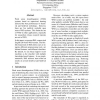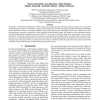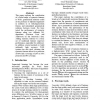80 search results - page 3 / 16 » Simple Features for Chinese Word Sense Disambiguation |
107
click to vote
NLP
2000
15 years 3 months ago
2000
In this article we compare the performance of various machine learning algorithms on the task of constructing word-sense disambiguation rules from data. The distinguishing characte...
ACL
2010
14 years 9 months ago
2010
Word sense disambiguation (WSD) systems based on supervised learning achieved the best performance in SensEval and SemEval workshops. However, there are few publicly available ope...
120
Voted
LREC
2010
15 years 1 months ago
2010
We propose a Word Sense Disambiguation (WSD) method that accurately classifies ambiguous words to concepts in the Associative Concept Dictionary (ACD) even when the test corpus an...
92
Voted
CICLING
2006
Springer
15 years 3 months ago
2006
Springer
The disambiguation of verbs is usually considered to be more difficult with respect to other part-of-speech categories. This is due both to the high polysemy of verbs compared with...
98
Voted
COLING
2002
14 years 11 months ago
2002
This paper explores the contribution of a broad range of syntactic features to WSD: grammatical relations coded as the presence of adjuncts/arguments in isolation or as subcategor...



